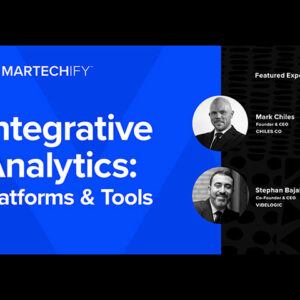Session Recap
CDPs in Action: Essentials for Implementing a Customer Data Platform
February 10, 2021 — In our Martechify discussion, two of our experts expand upon our November session by exploring ways to effectively implement Customer Data Platform (CDP) technology.
For this session, martech leaders Brian Prascak of Naratav and Rich Herbst of Ascend Marketing explain CDP implementation at each stage of the process, culminating in deep brand-customer relationships with continuous dialogue. They outline how developing quality use cases can better inform your decisions, and explain more ways that a 360-degree customer view can benefit your marketing campaigns.
Featured experts
Framework:
Fortunately, these hurdles are clearable with some thoughtful planning and cross-team collaboration. Our discussion included a number of important considerations related to implementing a CDP as smoothly and effectively as possible.
Know emerging CDP best practices
- Ensure you have a well-defined customer data strategy and CDP implementation plan—ideally, one that follows a gradual crawl, walk, run approach. You will need to establish relevant, specific use cases and KPIs for your customer data to make the most of your CDP’s capabilities.
- Assess your customer data landscape to seamlessly integrate your CDP with your existing data architecture. This means accounting for the way your data is retrieved and resolved, as well as any dependencies and blockers. You may want to create a flowchart!
- Pay attention to customer data stakeholders and workflow. As data ownership and access change hands and become more centralized, cross-team collaboration and proper training are required to handle the shift.
Refining your CDP implementation plan
Brian Prascak offered further insights for precisely defining the direction of your CDP implementation with use cases. You can develop use cases based on your overall data objectives and strategy; for example, if your goal is to improve customer digital engagement, your strategy may be to offer personalized product recommendations and your use case will reflect this. This will, in turn, help define which CDP features to prioritize when making a selection—in the example case, you will want a solution that can serve product recommendations based on a customer’s cart contents and preferences. Developing use cases and connecting them with potential capabilities will ensure that your CDP choice is ideal and well-optimized.
Importantly, as your customer data and relationships mature, you may find your CDP use cases and capability needs to evolve in tandem. Brian Prascak outlined how professionals “flow” between different use cases at each stage of CDP integration, leading to an end goal of continuous customer dialogue. In increasing order of maturity, here are some use cases mentioned:
- Integrated information – Capture and consolidate various data from all channels to create a secure source for insights and decisions.
- Predictive insight and precision marketing – Understand customer behavior and preferences; optimize messages for targeted omnichannel marketing.
- Personalized interactions – Share recommendations that are tailored for each customer and synchronized across channels.
- Continuous dialogue – Provide optimized, continuous communications that engage customers according to their preferences.
Prascak emphasized that CDPs’ integrated structure provides an opportunity for continuous customer development—that is, engaging customers consistently with the right content at the right time. Done correctly, everyone’s profile attributes, preferences, and journey stages can affect the personalized content they receive and when. Moreover, connecting and resolving identities across channels provides a consistent, 360-degree customer view, as well as a more seamless customer experince. Continuous development ultimately fosters deeper connections and creates enthusiastic brand advocates, as it allows for more responsive campaigns that anticipate customer needs.
Discussion and takeaways: Advice from our experts
Our experts discussed how good planning and quality use cases can drive an effective CDP implementation. Here are some highlights of their advice:
Prascak: On the operational side, find out who in IT is going to support your CDP implementation when it is not working. It’s important to know what resources you need and the expertise you’ll need to do it.
You want to make sure you have a good partnership with your CDP vendor; the devil is in the details. Get to a level of the specificity of what you are going to do beforehand so you can validate with the vendors.
Herbst: There is a marketing approach that says, “let’s take everything to a fine-grained, highly-responsive personalization,” and it becomes a heavy lift to do that all at once. A better idea is to break it up into stepping-stones, because the human organization and the marketing both need to evolve with the technology.
Related resources
Watch the recording
For more insights and takeaways from the session, watch the full recording here:












